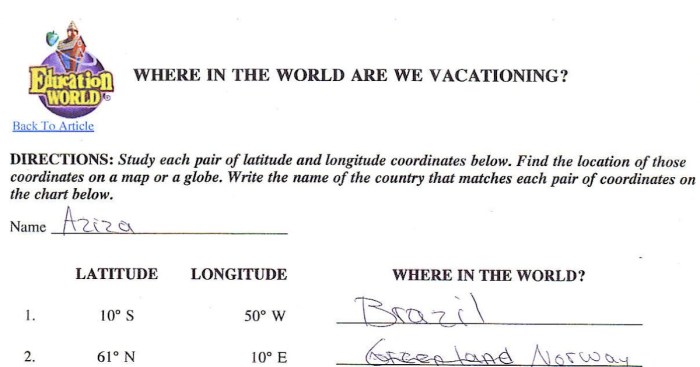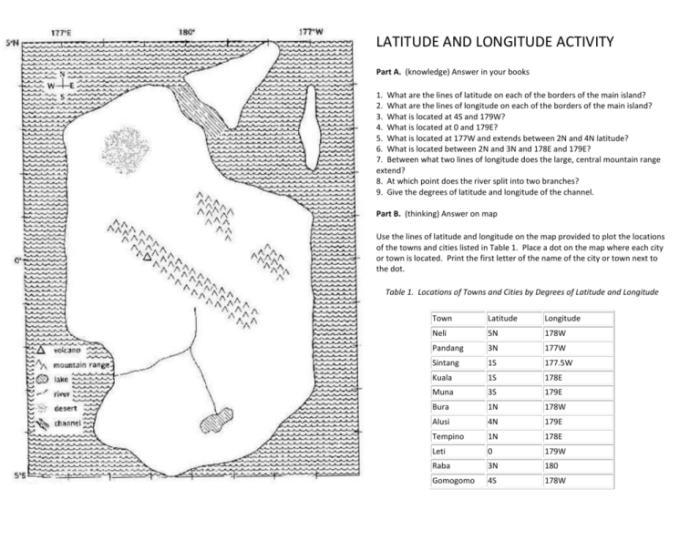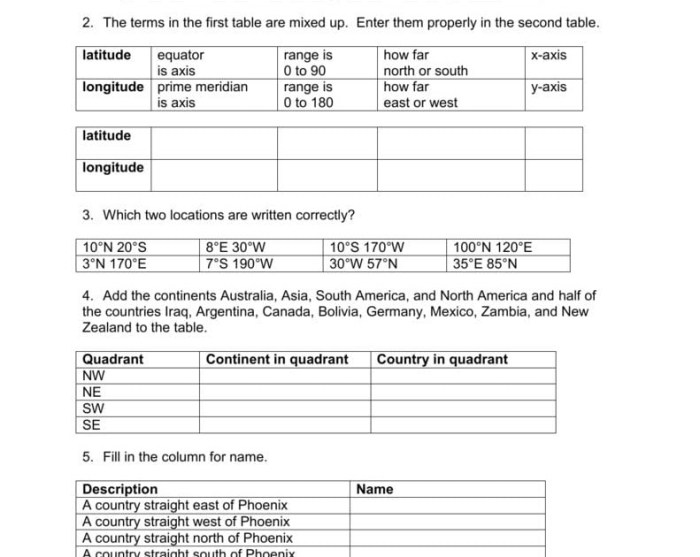Introducing the geography skills 2 recognizing latitude and longitude answer key, this comprehensive guide unlocks the secrets of navigating the globe with precision. Latitude and longitude, the cornerstones of any geographer’s toolkit, are explored in depth, providing a firm foundation for understanding the world’s intricate tapestry.
Delve into the practical applications of latitude and longitude, from their role in navigation and surveying to their significance in understanding global phenomena. This answer key empowers you to locate places, plan routes, and measure distances with newfound accuracy, opening up a world of possibilities for exploration and discovery.
Recognizing Latitude and Longitude: A Foundation

Latitude and longitude form the cornerstone of a coordinate system that enables us to pinpoint locations on Earth’s surface with precision. Latitude measures the distance north or south of the equator, while longitude measures the distance east or west of the prime meridian.
The Significance of the Equator and Prime Meridian
The equator is an imaginary line encircling Earth’s center, dividing it into the Northern and Southern Hemispheres. The prime meridian is another imaginary line passing through Greenwich, England, and serving as the reference point for measuring longitude.
Methods for Determining Latitude and Longitude

Using Maps and Globes
Latitude and longitude can be determined using maps and globes. Maps provide a two-dimensional representation of Earth’s surface, while globes offer a three-dimensional model.
Using a Protractor
A protractor is a measuring tool used to determine latitude and longitude on maps. By aligning the protractor’s base with the equator or prime meridian, the corresponding latitude or longitude can be read.
Using Online Tools and Mobile Apps
Numerous online tools and mobile apps utilize GPS technology to determine latitude and longitude. These tools provide real-time location data and can be particularly useful for navigation and surveying.
Applications of Latitude and Longitude: Geography Skills 2 Recognizing Latitude And Longitude Answer Key

Navigation
Latitude and longitude are indispensable for navigation, enabling ships, aircraft, and vehicles to determine their location and plan their routes.
Surveying, Geography skills 2 recognizing latitude and longitude answer key
In surveying, latitude and longitude are used to establish property boundaries, create maps, and determine elevations.
Geography
Latitude and longitude form the basis for geographic studies, allowing researchers to map and analyze the distribution of natural and human features on Earth.
Challenges and Considerations
Instrument Errors and Environmental Factors
Errors in determining latitude and longitude can arise from instrument malfunctions or environmental factors such as magnetic interference.
Reliable Sources and Up-to-Date Data
Accurate latitude and longitude measurements rely on reliable sources and up-to-date data. Using outdated or inaccurate data can lead to erroneous results.
Ethical Considerations
The use of latitude and longitude data raises ethical considerations related to privacy and data security. It is crucial to handle such data responsibly and in accordance with ethical guidelines.
Frequently Asked Questions
What is the significance of the equator and prime meridian?
The equator and prime meridian are imaginary lines that serve as the basis for measuring latitude and longitude. The equator divides the Earth into the Northern and Southern Hemispheres, while the prime meridian divides it into the Eastern and Western Hemispheres.
How can I measure latitude and longitude using a map?
To measure latitude on a map, align a protractor along the lines of latitude and measure the angle between the equator and the desired location. To measure longitude, align the protractor along the lines of longitude and measure the angle between the prime meridian and the desired location.
What are some real-world applications of latitude and longitude?
Latitude and longitude are used in a wide range of applications, including navigation, surveying, geography, and meteorology. They are essential for locating places, planning routes, and understanding the distribution of natural resources and climate patterns.